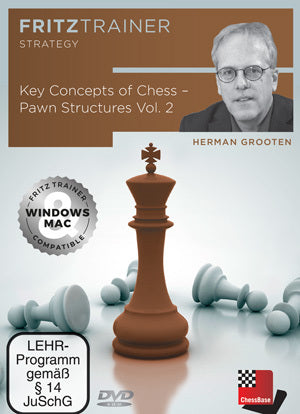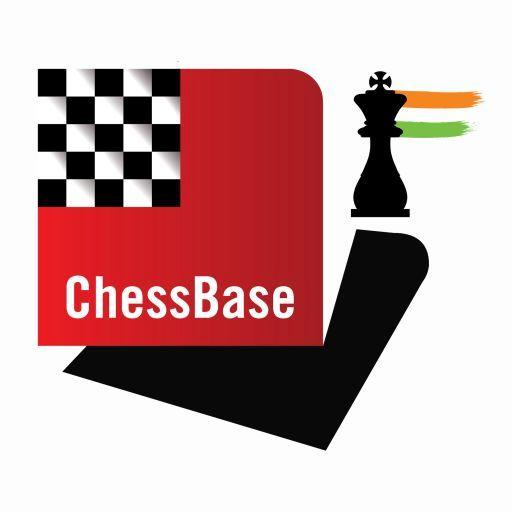Key Concepts of Chess - Pawn Structures Vol.2 by Herman Grooten
Key Concepts of Chess - Pawn Structures Vol.2 by Herman Grooten
Couldn't load pickup availability
Key Concepts of Chess - Pawn Structures Vol.2 by Herman Grooten
A new production in the “Key Concepts of Chess” series. The idea is to focus on certain themes by means of specific pawn structures. The central question is: how can the pieces be manoeuvred into good positions and what should we then consider? IM Herman Grooten offers rules-of-thumb and concepts to give club-chess players the necessary guidance so that they can try to find the right paths in their own games.
In this second part the emphasis will be on typical pawn structures that appear quite often in games, and that will be very recognizable for clubchess players. For example, on this video course the topics “the isolated queen pawn (IQP)” and “the passed-pawn in the middlegame” will be discussed in detail. Because the IQP can appear on the board in many opening variations, it is worthwhile to study. The fact that sometimes a passed-pawn can be invaluable and can cause an astonishing effect will be music to the ears of the club-chess player.
• Video running time: 4 hours (English)
• With interactive training including video feedback
• Extra: Model Games and Training with ChessBase apps - Play key pawn structures against Fritz on various levels
Sample video
- Introduction
- The Isolated Queen's Pawn Part 1
- Introduction, pro’s and con’s
- The Nxf7-sacrifice
- The pawn break d4-d5
- The pin over the d-file
- The Nxf7-sacrifice 1: Khenkin-Bertran
- The Nxf7-sacrifice 2: Iturrizaga-Papin
- The Nxf7-sacrifice 3: Botvinnik-Batuyev
- The Nxf7-sacrifice 4: Janev-Ilchev
- The Nxf7-sacrifice 5: Botvinnik-Vidmar
- The Isolated Queen's Pawn Part 2
- The rook lift and rook switch 1: Timofeev-Svidler
- The rook lift and rook switch 2: Buhmann-Wichmann
- The rook lift and rook switch 3: Onischuk-Vescovi
- The pawn break d4-d5 1: Ligterink-Donner
- The pawn break d4-d5 2: Portisch-Bilet
- The pawn break d4-d5 3: Sokolov-Fischer
- The pawn break d4-d5 4: Rodshtein-Diamant
- Transition to ‘hanging pawns’: Donaldson-Kudrin
- Exploiting weaknesses 1: Bojkov-Dreev
- Exploiting weaknesses 2: Arngrimmson-Damljanovic
- Exercises
- Description
- Exercise 1
- Exercise 2
- Exercise 3
- Exercise 4
- Exercise 5
- Exercise 6
- Exercise 7
- Exercise 8
- Passed Pawn Part 1
- To create a passed pawn 1: Razuvayev-Honfi
- To create a passed pawn 2: Nielsen-NN
- Pawn break: Thipsay-Peng
- Push pawn!: A.Haast-M.Bensdorp
- Piece positioning in relation to a passed pawn 1: Hughes-Chirila
- Piece positioning in relation to a passed pawn 2: Reinderman-Bosboom
- Piece positioning in relation to a passed pawn 3: Holt-Shetty
- To lure or chase away a defender: Cano Sanchez-Carrasco
- Interference: Morozevich-Adams
- Pin: Mentasi
- To block a square 1: Troitzky
- To block a square 2: Wall-Schuurman
- Double Attack: Engels-Maroczy
- Passed Pawn Part 2
- To exploit a passed pawn: Halkias-Asrian
- To create a second passed pawn 1
- To create a second passed pawn 2: Nunn
- To create a second passed pawn 3: Schuurman-Gara
- To defend against a passed pawn 1: Zenyuk-Abrahamyan
- To defend against a passed pawn 2: Van den Ende
- To defend against a passed pawn 3: Zheltukhov
- To defend against a passed pawn 4: Kasparov-Timman
- To exploit weaknesses and make use of the passed pawn 1: Grooten-Douven
- To exploit weaknesses and make use of the passed pawn 2: Petrosian-Korchnoi
- Exercises
- Description
- Exercise 1
- Exercise 2
- Exercise 3
- Exercise 4
- Exercise 5
- Exercise 6
- Exercise 7
- Exercise 8
Information regarding product delivery
Information regarding product delivery
*Pre-ordered digital products will be delivered by email on the launch date of that product.
Digital Products (Softwares, Magazines, etc)
All digital products are delivered instantly. Once your payment is successfully processed, you will receive the following instantly via email:
- Serial key
- Setup files
- Installation procedure
Please ensure you provide the correct email address during checkout, as the serial key and files will be sent to that email address instantly upon successful payment.
Physical Products (Books, Chess Sets, etc)
These will be shipped to your address via third-party courier partners.
We dispatch all orders (except customised t-shirts) within 1-2 days. Orders placed on weekends and holidays may take 1-2 additional days to ship, as we do not operate on these days.
Delivery timelines are as follows:
- Standard Delivery (India): 7–10 working days
- Express Delivery (India): 2–5 working days
- International Shipping: Estimated 2 weeks (may vary based on destination and customs)
You will receive a tracking link via email once your order is dispatched.
Regarding MacOS compatibility for softwares
Regarding MacOS compatibility for softwares
Although not officially supported on Mac, there is a workaround that people find helpful. You can check it here.
Important note for international customers
Important note for international customers
We sell digital products (softwares) and most of our physical products only in the following 11 countries:
India, Bangladesh, Nepal, Bhutan, Maldives, Sri Lanka, Thailand, Indonesia, Pakistan, Malaysia, Philippines.
If you do not belong to any of these countries, you can still buy some high-quality products that we ship worldwide. Please check those out here.
- Trusted Since 2016
- Premium Quality
- Free Delivery
Share




